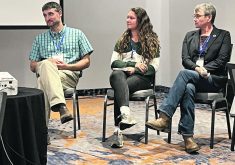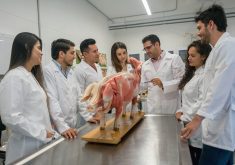LONDON, Ont. — Farmers interested in the grass-fed beef market can look to the example of Andy and Lisa Sproston.
Cuts from their Galloway cattle demand a premium at their on-farm store. Tenderloin sells for more than $60 a kilogram and New York strip loin for more than $45. Meaty soup bones sell for $14.95.
“There’s a great market, a niche market,” Andy Sproston said at last month’s Guelph Organic Conference in London.
“I can shift that easy, 30 or 35 cattle a year. All I have left right now are a few pounds of ground beef.”
Read Also

Canadian Food Inspection Agency extends chronic wasting disease control program consultation deadline
Date extended for consultation period of changes to CWD program
The couple and their two daughters are well situated for sales, considering that their farm is located just outside Grimsby in the middle of Niagara wine country.
They’ve built up their Galloway herd to 40 cows, which are pastured outdoors year round with hay provided in winter.
Sproston said he doesn’t argue that any particular breed is the best grass-fed option, although some of the heritage breeds that are adapted to grass may be a good fit.
He said farmers who are interested in the market should visit farms and shows as they look for the type of animal they like.
The Sprostons settled on Galloways, which come in two colours: black and dun. Belted Galloways, also known as belties and oreos, are distinguished by their distinct colouration: black with white around the middle.
Galloways are naturally polled and tend to be smaller than other beef breeds. Calves are around 70 pounds when they’re born.
Sproston said he’s only had one calving issue over the years: a backward leg.
The breed is recognized for its mothering, calm disposition and ability to convert sparse pasture into beef.
Milk output is modest, but enough for a calf or even twins, Sproston said. He allows his cows to wean their own calves because it only made a difference of two to three weeks when he used to intervene.
He finishes animals in 30 to 36 months on only pasture and hay, although occasionally an animal will finish sooner. Dress weights are 800 to 900 pounds.
“Some of my best beef has been from a January slaughter, but a lot of people aim at just after the fresh spring grass comes on.”
Sproston said his carcasses would likely be discounted if shipped to a regular packer, but that hasn’t kept him from building a loyal clientele.
Galloways don’t carry a lot of exterior fat. Instead, it’s their thick coats that keep them warm in winter, similar to Highland cattle.
The fat that is accumulated tends to be marbling and has a healthy fatty acid profile, Sproston said.
The farm’s website at www.ourgatetoyourplate.com.















